AIAA Member Spotlight – September 2018 Written 25 September 2018
AIAA Profiles AIAA Student Members and 2018 Abe M. Zarem Awardees Geoffrey Andrews and Ken M. Mitchell
By Lawrence Garrett, AIAA Web Editor
With the calendar turning toward fall and colleges and universities back in session, the Institute’s September spotlight has fittingly come to rest on two outstanding AIAA student members: Geoffrey Andrews, the 2018 AIAA Foundation Abe M. Zarem Awardee for Distinguished Achievement in Aeronautics; and Ken M. Mitchell, the 2018 AIAA Foundation Abe M. Zarem Awardee for Distinguished Achievement in Astronautics.
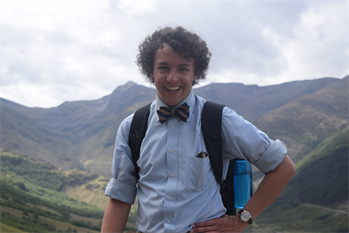
Andrews, a second-year Ph.D. student in aerospace engineering at Purdue University, and Mitchell, a mechanical engineering graduate student at the University of Memphis, both said their initial passion for engineering was ignited by their fathers.
“I was introduced to mechanics by my father who raised me to work with my hands and taught me how to repair a variety of machinery from cars and lawn mowers to go-karts and shop equipment,” Mitchell explained. He also credited opportunities to attend a number of airshows as a young child, saying that “from there, my passion for aerospace grew while attending college, surrounded by professors in the field of heat transfer, fluid mechanics, and thermodynamics.”
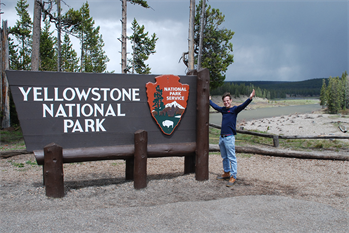
Andrews notes that he’s been “obsessed with science and aircraft for as long” as he can remember, and that if “there’s anyone to blame for that, it’s my father” – a materials scientist and engineer whose passion for engineering is “infectious.”
“There’s perhaps no better testament to this,” Andrews shared, “than the airplane he hung from our ceiling – he spent months building a faithful 1/5th-scale model of his favorite plane (the Supermarine Spitfire) and was so proud of it that he decided to suspend it in the middle of the living room. … I grew up designing and building all sorts of things with my dad in our basement workshop.” Having these experiences, it was nearly a given that he’d end up pursuing aerospace engineering.
Andrews joined AIAA in September 2014 after his professor, former astronaut Terry Hart – who returned to his alma mater to teach aerospace engineering following his time at NASA – gave him an AIAA journal to look through. Shortly thereafter, he decided to get involved with AIAA by forming his own Student Branch at Lehigh University in the hopes of growing interest in aerospace engineering at his school. A lot of his classmates in the mechanical engineering department were “crazy about aerospace,” but weren’t “a very cohesive or clearly-defined group,” and he thought “having a Student Branch of AIAA could help.”
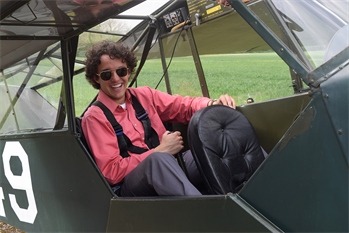
A couple of years later, in January 2016, the Institute welcomed Mitchell as a new student member. He said he first learned about AIAA “through a few awards and posters hanging in the mechanical engineering hallway” at his school, the University of Memphis. He credits his faculty advisor and AIAA Lifetime Member, Dr. Jeffrey Marchetta, for getting him involved with the Institute.
“He told me about an upcoming student conference and invited me to come along to watch a graduate student,” Mitchell recalled. The conference, which took place in Huntsville in 2016, was “an amazing experience” that included not only a tour of the U.S. Space & Rocket Center, but also NASA Marshall Space Flight Center. Mitchell expressed that he “couldn’t have had a better first experience with AIAA.”
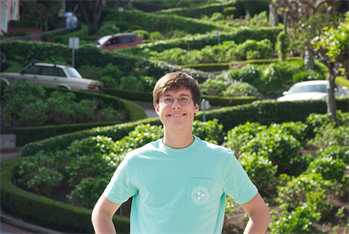
Introduced by his father to engineering, and by Dr. Marchetta to AIAA, Mitchell credits both of his parents for instilling within him a separate and unique set of skills. Raised by two hearing-impaired parents, Mitchell’s first language was sign language, which fostered his intellectual growth from an early age. “I was forced to help my parents communicate [with] the outside world whether at the bank, school, doctor, or even a restaurant,” Mitchell shared, adding, “those situations rapidly developed my communication skills by teaching me situational awareness and logical reasoning [that] another child my age would not normally acquire.” Serving as an interpreter for his parents helped teach him “that no questions were dumb questions,” and to listen, ask probing questions, and not be afraid to speak up.
Andrews and Mitchell both have been active in the Institute during their tenures. After founding the AIAA Student Branch at Lehigh, Andrews served as the chair, and within weeks of having graduated with his B.S., he joined the AIAA K-12 STEM Outreach Committee, referring to the opportunity as “the perfect way for me to stay active and to expand my AIAA experience beyond the student level.” He also entered an AIAA graduate aircraft design competition because he thought “that designing a new aircraft from the ground up would be fun – and it was.”

Mitchell also served as Student Branch chair at the University of Memphis and has participated in several AIAA Regional Student Conferences. After attending his first student conference, he knew that AIAA was something he “wanted to be a part of,” and said it was the first time he felt he could be part of “something special that would benefit me the rest of my life.”
Andrews and Mitchell credit AIAA for positively impacting their collegiate careers. Andrews said he’s enjoyed the chances to meet “some really fascinating and successful people through AIAA functions,” and that getting to hear from “some of AIAA’s more accomplished and distinguished members is always thought-provoking and inspirational, and many of them have valuable career advice to offer.”
Mitchell credits AIAA for internship and research opportunities he has received, and he also has won several AIAA honors, including second place in the undergraduate division of the 2017 Region II Student Conference and second place in the graduate division of the 2018 Region II Student Conference. “Dr. Jeffrey Marchetta shaped my academic career with AIAA being the platform for which I showcased myself,” said Mitchell, admitting that by following his professor’s guidance and becoming active in AIAA, Mitchell has “had moments of feeling like a ‘superstar.’”

One of those moments came this past year when he learned he was the recipient of the 2018 Abe M. Zarem Award for Distinguished Achievement in Astronautics for his research paper “Thermal Conductivity and Specific Heat Measurements of an RTV-655/Polyimide Aerogel Compound at 77K and 298K.” Mitchell “immediately thought of Dr. Marchetta and how it would not have been possible without him.” He said the news “ took several days to sink in.” The paper is based on his work with a relatively new technique for measuring thermal properties that uses a transient plane source.
“The idea of using linear optimization to solve an analytical solution of the average temperature increase of a certain sensor geometry to obtain thermal conductivity and specific heat otherwise measured separately is fascinating,” Mitchell observed, “I have pushed the technique beyond its limitations measuring low density and high insulating materials as well as using it at cryogenic temperature, which is important to the increase in popularity of this technique.”
Andrews described the moment he heard that he’d been named one of two 2018 Abe M. Zarem award recipients as one of “disbelief, immediately followed by shock.” Earning the award for distinguished achievement in aeronautics for his paper “A Hybrid Length Scale Similarity Solution for Swirling Turbulent Jets,” Andrews said he was pleased with the unique approach he took with his model aircraft and was “pleasantly surprised … to see it granted such recognition.”
As part of the honor of being named the 2018 Abe M. Zarem Award winner for distinguished achievement in aeronautics, Andrews was afforded the opportunity to travel to Belo Horizonte, Brazil, to participate in the student paper competition of the 31st Congress of the International Council of the Aeronautical Sciences (ICAS), his first international conference experience, where he hoped to get “a more global snapshot of what’s going on in my field.”
As part of Mitchell’s award, he will travel to Bremen, Germany, to participate in the student paper competition of the 69th International Astronautical Congress (IAC) taking place 1–5 October. There, he looks “forward to speaking and networking with international companies and students … to gain a worldly insight of the aerospace and astronautics industry.”

Andrews and Mitchell also will be honored at an awards luncheon at the 2019 AIAA SciTech Forum in January. Andrews said he’s looking forward to seeing some friends and colleagues from other research institutes, in addition to immersing himself in the “pleasantly overwhelming experience of AIAA’s mega-conferences.” Having only attended AIAA student conferences to date, Mitchell is also excited to attend AIAA SciTech in January for the opportunity “to see the environment of a professional AIAA conference.” At both IAC 2018 and 2019 AIAA SciTech, Mitchell said he’s eager to learn what’s “in store for the future of aerospace and astronautics as well as learn about cutting-edge technology.”
Touching on some of those cutting-edge technologies, Andrews said he believes the aerospace industry is “already at the early stages of a lot of disruptive technologies,” citing 3D printing, reusable launch vehicles, and the promise of electric aircraft and urban air mobility. However, Andrews suggested that one of the most significant transformations on the horizon may not be technological, but instead cultural.
“We are seeing a huge wave of entrepreneurial innovation that is driving the industry and new and exciting directions. For now, much of aerospace is dominated by a few familiar and massive companies, but with all the startup companies looking to rapidly develop everything from flying cars to lunar landers (and making impressive strides toward those goals) who knows how much longer that status quo will remain,” Andrews explained.
Mitchell predicted that the future of space exploration will be largely dependent upon advancements in materials and methods for cryogenic storage and environmental stabilization.
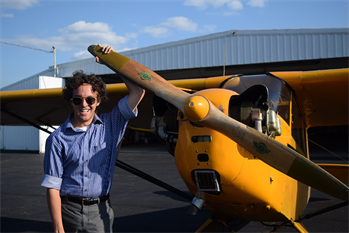
“New materials will increase the longevity of cryogens in space and allow astronauts to reach deeper into space,” Mitchell explained, forecasting that they “will not only benefit cryogenics but every aspect of aerospace from electronics to breathing apparatuses to 3D printing.” New materials “will allow previously impossible feats of engineering to be possible and increase the efficiencies of current technologies to make better use of the world’s energy.”
After Mitchell earns his Master’s, he intends to pursue opportunities outside of academia, and will seek either a full-time or recent graduate training position with an aerospace company. He’s eager to get some professional experience under his belt and ultimately work toward taking the professional engineering exam. Additionally, he is working on his MBA, which he hopes to wrap up by the end of the 2019 summer semester.
In their free time, Andrews and Mitchell each enjoy participating in a variety of activities. Mitchell described one of his favorite activities as going to the park to throw the frisbee for his two dogs, Stella and Naomi. He also enjoys traveling at least once a year, as well as simply being outdoors, “no matter what the activity is.”
Andrews said that he has “a lot of hobbies,” including playing his horn and piano, baking, sailing, and hiking. But as a licensed private pilot, he naturally enjoys flying the most. “If I had to pick just one it would have to be flying.”
Having earned his pilot’s license at 17, Andrews has now earned his instrument rating through Purdue University’s flight club and has been able to pursue two of his “longstanding dreams – flying warbirds and other vintage aircraft, and flying aerobatics.” He’s also been training the past year to fly competition aerobatics, which is “a much more fun way to learn about aerodynamics than sitting in a classroom.”
The Institute congratulates Geoffrey Andrews, 2018 AIAA Foundation Abe M. Zarem Awardee for Distinguished Achievement in Aeronautics, and Ken M. Mitchell, 2018 Abe M. Zarem Awardee for Distinguished Achievement in Astronautics, and salutes them for the outstanding examples they have each set for future generations of aerospace engineering students to follow. We wish them all the best as they pursue their respective careers and undoubtedly evolve into leaders in our industry.
